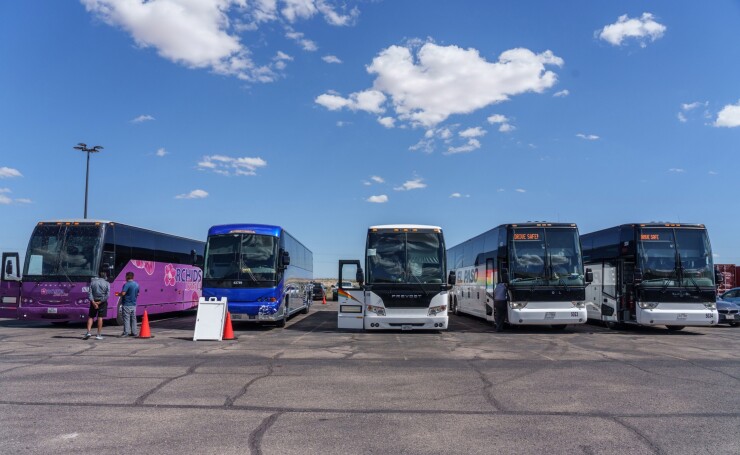Migrant arrivals in Illinois suburbs raise public finance questions
6 min read

When buses ferrying migrants north from Texas began arriving in Naperville, Illinois, which is roughly 30 miles from Chicago, local officials were caught off guard.
“We had a total of six buses in December and they went directly to the Metra train station with occupants boarding trains to Chicago,” Naperville Director of Communications Linda LaClouche said. “We did not receive any prior notification of this and became aware of this after it happened.”
After those buses dropped off their riders, the city started planning for migrant arrivals and forged an emergency operations plan, LaClouche said.
Bloomberg News
“Given how the situation has evolved and changed, we continue to update our plan,” she said.
Naperville has a population of 149,936 and a median household income of $143,754,
It’s one of a laundry list of Illinois suburbs — at least 20 in the greater Chicago area — to which Texas Gov. Greg Abbott has been busing migrants since the city of Chicago
In Naperville, the migrants’ arrival brought well-wishes from some residents but also discord. City Council member Josh McBroom in a Jan. 16 City Council meeting called on his neighbors to house migrants in their own homes, proposing the city start a sign-up sheet.
McBroom, who is a Republican,
Over a half-dozen Illinois suburbs affected have passed or
With Illinois Gov. JB Pritzker about to release his 2025 budget proposal this week and Chicago budgeting only $150 million for migrants in 2024, less than half of what it spent on them in 2023, this latest twist in the migrant busing saga raises further questions about its implications for public finance at the local level.
“It’s not necessarily that folks in the suburbs don’t want the migrants in their communities,” said Justin Marlowe, research professor at the University of Chicago’s Harris School of Public Policy and director of the school’s Center for Municipal Finance. “Even if you have a lot of people in your community who are eager to help, they just can’t, because the infrastructure doesn’t exist in the community to help. They’re just not equipped to do right by these folks when they arrive.”
And even if the migrants don’t stay in the suburbs long, potential costs such as overtime pay for first responders, translators and social workers raise the prospect of strained public safety budgets in the short term, said Marlowe.
In the long term, the migrants’ arrival translates to more spending in the state Medicaid program, more expensive emergency room visits and increased spending needs for local school districts, he said.
“There’s definitely an impact on the local government, on the regional governments — Metra, the PACE bus system — and then certainly, to the extent that a lot of them are coming to the city to work, there’s an impact on the city,” he added. “There’s a variety of things that have to happen anytime these folks just kind of arrive. There’s limited space with respect to shelters.”
The city of Chicago spent over $360 million on migrants bused from Texas last year, and those costs are not about to decline, said Bryce Hill, director of fiscal and economic research at the Illinois Policy Institute, a nonprofit think tank with libertarian leanings.
“Migrant care takes money the city hadn’t originally planned on spending and can’t now spend on other issues,” he said, noting that requests from mayors of large cities for $5 billion in federal aid went unmet by the Biden administration.
“Unplanned and ever-increasing costs associated with the migrant crisis put municipal budgets at risk,” he added. “More migrants continuing to land in Illinois will likely put more financial strains on state and local budgets. State and local governments could see credit ratings downgrades if ratings agencies perceive this as increasing risks for bond holders.”
Marlowe said he didn’t see the problem approaching the scale where it would affect bond ratings, but he acknowledged that some of the fiscal pain initially felt by Chicago is now spreading elsewhere.
In many suburbs, the migrants have boarded public transit toward Chicago. Yet Marlowe said he’s now hearing of places in Lake County taking in migrants who caught a Metra train downtown only to learn they could get help north of Cook County, in cities like Waukegan and North Chicago.
But the services that migrants need are not services that cities typically provide. Marlowe pointed to networks of nonprofits and faith-based organizations in cities like Chicago. Scaling those up can strain partnerships between those networks and cities, he said. It can also strain relationships between state and local governments, as has been the case in Illinois, where Pritzker has occasionally voiced frustration with Chicago’s plans to deal with the crisis.
And then there’s the fact that Chicago already has a sizeable homeless population — at least 68,440 at last count, according to a 2023 report from the
“When the city is thinking about the scale of the problem of homelessness, they’re talking about real estate transfer tax changes,” Marlowe said. He said the revenues from planned real estate transfer tax changes, which have been estimated at $100 million, could also go to the migrants arriving from Texas.
The number of migrants crossing the border with Mexico is up substantially. In fiscal 2023, U.S. Customs and Border Protection recorded 2.48 million
Abbott bused more than 31,300 migrants to Chicago between August 2022 and Feb. 2, his office said in a press release.
“There’s no guarantee the increase [in taxes] will generate the funds [Chicago Mayor Brandon] Johnson claims,” said IPI’s Hill. “As the ballot initiative is defined, Johnson could use this money as a slush fund for any initiative so long as it loosely relates to ‘homelessness.’ This could mean subsidized rental assistance for migrants, third-party vendors at migrant shelters or even salaries for teachers. Johnson has not articulated an exact plan for how the money will be spent.”
Meanwhile, many of the nonprofit and faith-based service providers that Marlowe referred to have established intake pipelines designed for locals. But the migrants are a different matter.
“When those pipelines don’t exist, and you’re having to create them… it becomes even harder,” Marlowe said. “You are seeing social services agencies go out and either through grant dollars or through redirecting some of their own dollars, hire more social workers. They need to double or triple their budget overnight. They’re willing, but the question is, can they?”







